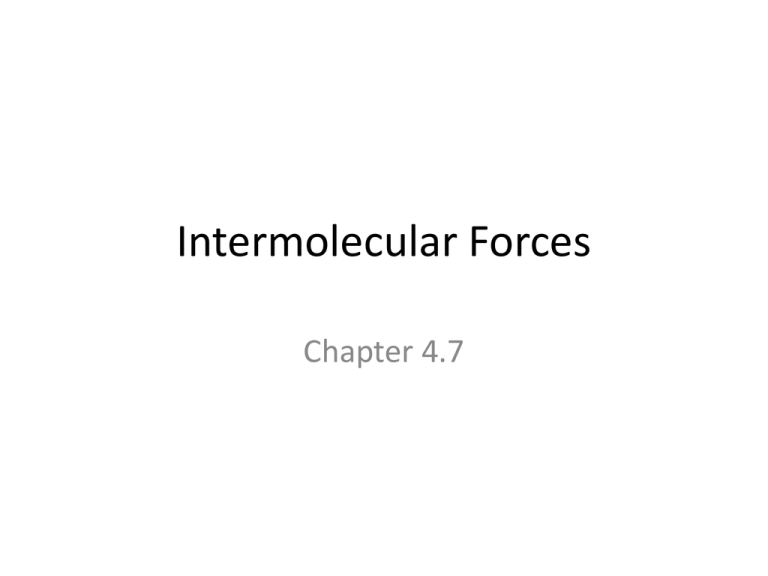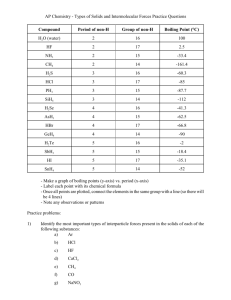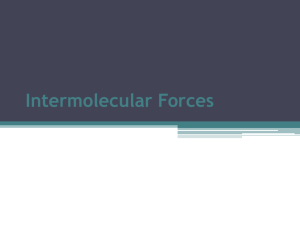Intermolecular Forces Chapter 4.7
advertisement

Intermolecular Forces Chapter 4.7 Intramolecular vs. Intermolecular • An intramolecular bond is the chemical bond within a molecule • An intermolecular force is a force that occurs between molecules States of Matter 3 Types of Intermolecular Forces 1. London Dispersion Force 2. Dipole-Dipole Force 3. Hydrogen Bonds London Dispersion Force Attraction resulting from a random momentary non symmetrical electron distribution You can also think of it as the negative electrons from one molecule being attracted to the positive nucleus of a adjacent molecule London Dispersion Force • All molecules experience London Dispersion Forces, but they have the greatest impact in non-polar molecules • London Dispersion Force is the weakest intermolecular force • The strength of the London force increases with: – Increasing size – Increasing surface area of contact or proximity Dipole-Dipole Force • The dipole-dipole force is the electrostatic attraction that is caused when the dipoles of polar molecules position their positive and negative ends near each other Dipole-Dipole Force • Only polar molecules experience Dipole-Dipole forces • Dipole-Dipole forces are stronger than London Dispersion forces (but are still only 1% as strong as covalent or ionic bonds) • The strength of the Dipole-Dipole force increases with: – Increasing polarity – Decreased distance between molecules Hydrogen Bonds • A hydrogen bond is the strong dipole-dipole interaction that occurs when a hydrogen atom bonded to a small highly electronegative atom (oxygen, nitrogen, or fluorine) is attracted to a partially negative atom on a nearby molecule Hydrogen Bonds • Only molecules that have O, N, or F attached to H experience hydrogen bonding • Hydrogen bonds are the strongest type of intermolecular force (but they are still 10-20 times weaker than covalent bonds) Intermolecular Forces and Physical Properties • The stronger the intermolecular forces are, the more energy it will require to pull the molecules apart • Molecules that have strong intermolecular forces also have high melting points and boiling points • Intermolecular forces can also affect solubility Intermolecular Forces and Physical Properties Intermolecular Forces and Physical Properties explain the trend explain the trend Intermolecular Forces and Physical Properties explain the trend explain the trend Intermolecular Forces and Physical Properties explain the trend H3C N CH3 CH3 trimethylamine, b.p. 3.5°C explain the trend CH3CH2 N CH3 CH3CH2CH2 N H H ethylmethylamine, b.p. 37°C propylamine, b.p. 49°C H Physical Properties of Liquids • Surface Tension is the resistance of a liquid to increase its surface area • The stronger the intermolecular forces, the greater the surface tensoin OBSERVATION EXPLANATION Physical Properties of Liquids • Capillary action is the spontaneous rising of a liquid in a narrow tube due to adhesive and cohesive forces Glass (SiO4) Physical Properties of Liquids • Viscosity is the measure of a liquid’s resistance to flow • Liquids with strong intermolecular forces tend to be more viscous • Ex: Vegetable oil is more viscous than water HOMEWORK Required Reading: p. 239-247 (remember to supplement your notes!) Questions: p. 244 #1-2 p. 247 #1-8




